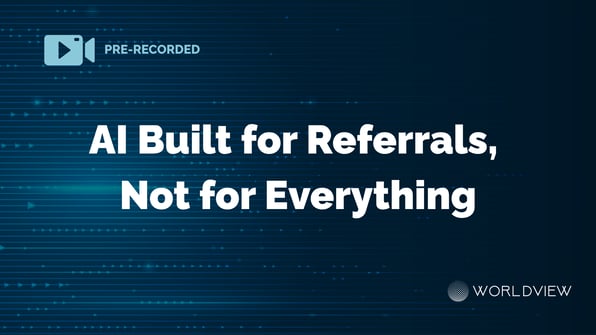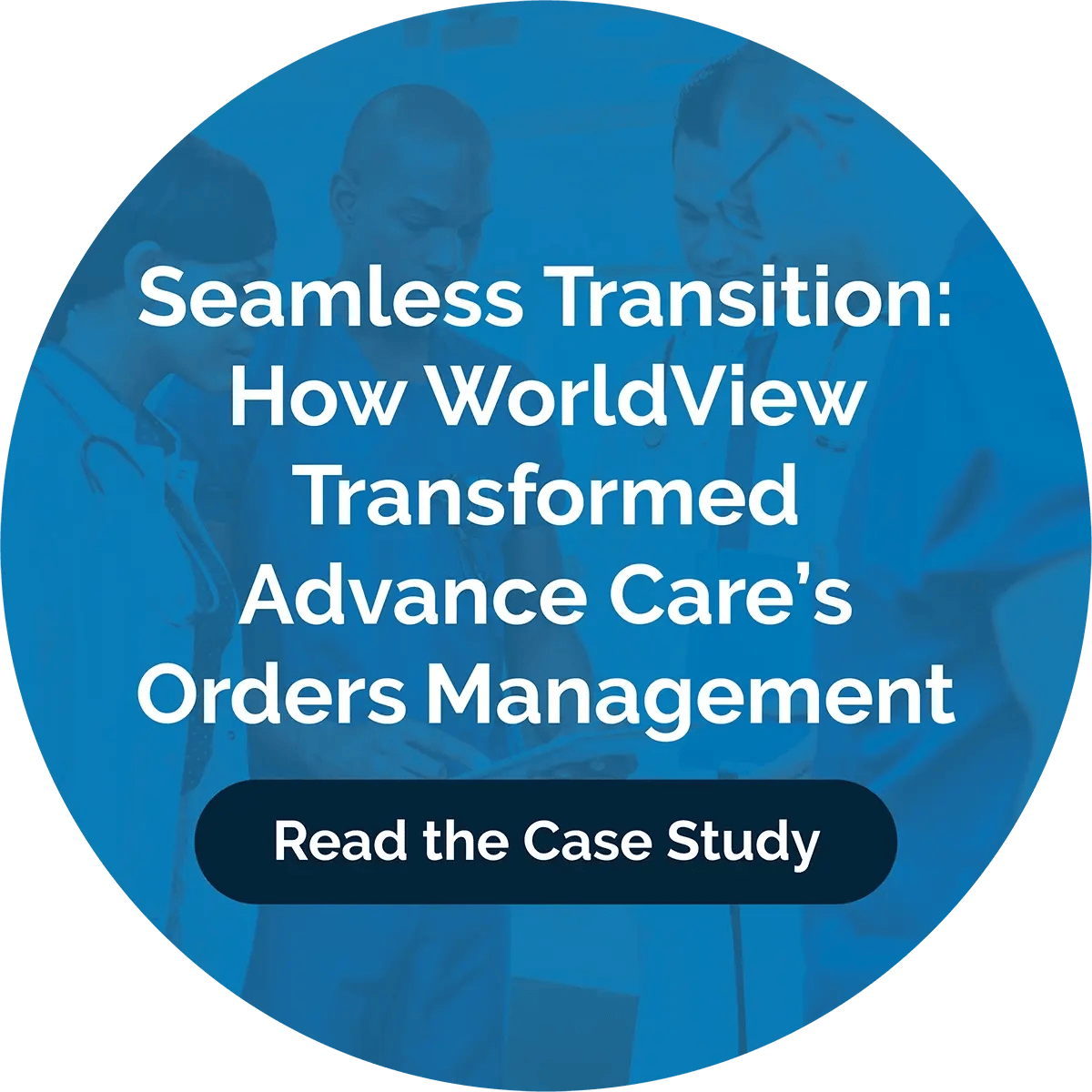Webinar Recording: AI Built for Referrals, Not for Everything

AI can be a powerful tool for home health and hospice agencies, but only when it’s designed for the job. In this mini webinar, we break down how AI improves referral intake workflows without replacing the human decision-making that’s critical to patient care.
You’ll learn how using the right AI tool can simplify document-heavy processes, reduce intake delays, and help your team focus on what matters most—delivering care.
What you’ll learn:
✅ Why AI built for general use often backfires in healthcare – Time stamp: 2:01
✅ How the right AI speeds up intake without making decisions for you – Time stamp: 3:44
✅ How to cut intake time from hours to minutes while keeping control – Time stamp: 5:32
✅ How to handle both digital and faxed referrals in one system – Time stamp: 11:57
✅ How referral partners notice when your intake improves—and why that matters – Time stamp: 8:01
Plus, hear tips on avoiding false positives, preventing missed documents, and helping intake teams trust the process—without losing their role in it – Time stamp: 10:24
WEBINAR TRANSCRIPT
Cortney Swartwood [00:04]
Hey everyone, and welcome. Thanks for joining the second session in this mini webinar series. I’m Cortney Swartwood, Senior Marketing Manager here at WorldView. Today’s session is called “AI Built for Referrals – Not for Everything.”
Before we get started, a few quick housekeeping items. On your screen, you’ll see windows for the presentation, Q&A, and a survey. You can move and resize those however you like. If you have questions, please drop them in the Q&A window, not the chat. That helps us track them better, and we’ll answer them directly there. If you run into technical issues, you can also use the Q&A for help.
There’s a Resources icon on the toolbar where you can download today’s slides. This webinar is being recorded, and we’ll send you a link to the on-demand version tomorrow so you can rewatch it or share it with your team.
Today’s topic is a big one. We’re talking about AI, but instead of the usual hype, we’re focusing on how it actually works in referral intake. Specifically, how it helps when it’s built for the job—and why trying to use AI for everything can cause more problems than it solves. I’m going to pass it over to Cody Godley to lead the conversation.
Cody Godley [01:48]
Thanks, Cortney. And thanks to everyone joining today. This is a big conversation. AI is everywhere right now, but when it comes to healthcare referrals, not all AI is helpful—and most AI isn’t actually built for this space.
A lot of tools out there try to automate everything. But in healthcare intake, that approach can create more problems than it solves. You don’t want AI making care decisions for your team. You don’t want it guessing at eligibility or removing human judgment from the process.
What you do want is AI that supports your team—cutting through the noise, flagging key details, and helping prioritize what matters. That’s exactly what Referral AI does. It’s designed to read referral documents, recognize patterns, sort them into service lines like home health or hospice, and highlight payer types, diagnoses, and other critical details.
It generates summaries and creates cover pages with everything your team needs to take fast, accurate action. But your team still makes the decisions. The AI doesn’t approve referrals or determine eligibility. It simply speeds up the process and reduces the clutter.
Cody Godley [03:44]
When AI tries to do too much, it backfires. You end up with false positives, errors, and frustrated staff who don’t trust the tool. I’ve worked with agencies that tried generic AI tools designed for general document routing, and they ended up spending more time fixing the mistakes than they would have doing it manually.
That’s why the AI has to be trained specifically for healthcare referrals. It has to understand your documents, your patterns, and your workflows. Referral AI, powered by Kno2, was built for exactly that.
Cody Godley [05:32]
The best results come from pairing AI with human decision-making. AI does the sorting and flagging. Your team stays in the driver’s seat. For example, when a referral comes in, the AI flags whether it’s for home health, hospice, or another service line. It builds a summary with all the relevant details. Your intake nurse sees that in real time, can immediately call the family or facility, and spends less time digging through paperwork.
Cody Godley [06:41]
When you’re evaluating any AI tool, there are a few key questions you should ask. Is it built specifically for healthcare referrals? Is it HIPAA compliant? Can it handle both faxed and digital documents? Does it learn over time based on your workflows? And most importantly, can you trust what it’s flagging?
If the answer to any of those is no—or if the tool tries to take over the entire intake process for you—it’s probably not the right fit. Smart AI runs in the background. It eliminates the grunt work of digging through documents and searching for key data points. But it doesn’t replace your team’s judgment.
Cody Godley [08:01]
When AI works the way it should, the impact is huge. Response times drop from hours to minutes. Referrals stop getting lost in inboxes. Your intake staff spends more time on clinical conversations and less time hunting for documents.
And something people don’t always think about—your referral partners notice. When your intake is fast, organized, and responsive, it builds trust. And that trust leads to more referrals.
Cody Godley [08:29]
If there’s one thing to remember from today, it’s that AI can be an incredible help in referral intake, but only when it’s designed for that job. It should never replace your team. It should support them. And it should be trained to recognize the documents and details that actually matter in home health and hospice.
Cortney Swartwood [08:29]
Thank you, Cody. That was really helpful. I think it’s clear that AI isn’t magic, but when it’s used the right way, it becomes a powerful tool for intake teams who are tired of digging through inboxes and playing document detective.
Let’s jump into some questions.
Cortney Swartwood [09:03]
First question: What makes WorldView’s AI different from other tools?
Cody Godley [09:06]
Great question. Most AI tools are built for generic document routing. Referral AI is trained specifically on healthcare referrals. It knows how to pull the right details, identify urgency, and prioritize the right documents. Plus, it learns how your agency works over time.
Cortney Swartwood [09:31]
Thank you for clarifying. Next question: Can AI help identify duplicate referrals?
Cody Godley [09:39]
Absolutely. AI can recognize when a patient name, date of birth, and diagnosis match something already processed. Instead of accidentally processing it twice, the system flags it so your team can check first—saving time and avoiding rework.
Cortney Swartwood [10:02]
That makes a lot of sense. I know teams are really over having to do rework for something they’ve already processed. Next question: My team is worried AI might miss something. How do you avoid that?
Cody Godley [10:24]
That’s a great question. That’s exactly why we keep the human review process in place. The AI does the first pass—sorting, flagging, summarizing—but your team still makes the final call. And the more the AI sees, the smarter it gets.
Cortney Swartwood [10:57]
That makes total sense. I think a lot of teams like to stay hands-on but would love to avoid the extra rework. Next question: How fast is the turnaround time once a referral comes in?
Cody Godley [11:18]
Usually within minutes. The AI flags the referral, creates the summary, and routes it to the right place. That’s how teams go from inbox to intake in under 15 minutes.
Cortney Swartwood [11:41]
That’s obviously way faster than the manual process. Very exciting for intake teams. Last question for today: Does this work with both faxes and digital referrals?
Cody Godley [11:57]
Yes, absolutely. Whether the referral comes from your EMR fax server, secure messaging, or a portal, Referral AI pulls everything into one queue. No more bouncing between platforms. Everything is in one place.
Cortney Swartwood [12:25]
Thank you so much, Cody. And thanks to everyone who joined today. If we didn’t get to your question, we’ll follow up with you directly. Be sure to join us for the next session, “From Inbox to Intake in 15 Minutes,” where we’ll show how top-performing teams cut down lag time and move referrals faster with better systems and processes.
We’d love your feedback, so before you go, please complete the survey on your screen. Thanks again for joining, and we’ll see you next time.
Blog Post Tags
Industry Insights, Healthcare, Hospice, AI, referrals, General, Blog, leadership, Referral AI, Healthcare TrendsGet Awesome Content Delivered Straight to Your Inbox!
Posts by topic
- Healthcare
- Business
- AI
- Hospice
- AP Workflows
- Home Care Management
- hospice-care
- General
- Industry Insights
- agency
- Blog
- Commercial
- reporting
- Data Analytics
- billing
- referrals
- News
- Referral AI
- business goals
- Operations
- business development
- partners
- Integration
- Healthcare Trends
- leadership
- Medicare
- Compliance
- audit
- medicaid
- Better Charting
- regulations
- Application
- Automation
- finance
- CRM
- DMSi
- Events
- KanTime
- Press Release
- Revenue Growth
- Announcements
- Artificial Intelligence
- EHR
- ESign
- Guides
- Homecare Homebase
- Mobile
- Physician Order Tracking
- axxess
- clinical
- interoperability
- payor See All See Less


.png?width=596&name=WV%20Hc%20Clinical%201%20Web%20(3).png)
.png?width=596&name=WV%20Hc%20Clinical%201%20Web%20(2).png)
.png?width=596&name=WV%20Hc%20Clinical%201%20Web%20(5).png)